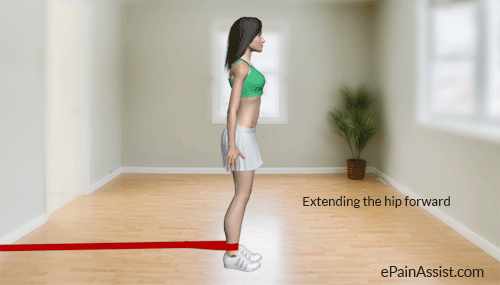Meralgia Paresthetica or Bernhardt-Roth Syndrome is a condition where the patient experiences burning pain, tingling, and numbness in the outer part of thigh.
Causes of Meralgia Paresthetica or Bernhardt-Roth Syndrome
Compression of lateral femoral cutaneous nerve, sensation supplying nerve to the skin surface of the thigh, causes meralgia paresthetica. Some of the common causes of meralgia paresthetica are wearing tight fitting clothes, obesity or gaining weight, and pregnancy. However, it can also be caused due to other reasons such as other medical conditions like diabetes or local trauma. In majority of the cases, the conservative measures, such as switching to looser clothing, losing the excess weight etc can provide relief from Meralgia Paresthetica or Bernhardt-Roth Syndrome. If conservative measures do not benefit, then treatment comprises of medications to help alleviate discomfort and sometimes, very rarely, surgery.
Etiology and Risk Factors of Meralgia Paresthetica or Bernhardt-Roth Syndrome
The lateral femoral cutaneous nerve is the nerve that provides sensation to the outer thigh surface. The compression of this nerve causes meralgia paresthetica. As the lateral femoral cutaneous nerve is a sensory nerve, the ability to use leg muscles does not get affected. In many individuals, this nerve travels through the groin to the upper thigh without any hindrance; but in meralgia paresthetica, the lateral femoral cutaneous nerve becomes pinched/compressed/trapped usually under the inguinal ligament. Conditions which increase the pressure on the groin are the common causes of this compression, such as:
- Tight clothing
- Overweight/obesity
- Pregnancy
- Presence of scar tissue near the inguinal ligament. It could be due to injury or a previous surgery.
- Standing, walking or cycling for prolonged periods of time.
- Injury to the nerve can occur in a motor vehicle accident or in diabetes causing meralgia paresthetica.
Risk Factors for Meralgia Paresthetica or Bernhardt-Roth Syndrome
- Being overweight or obese increases the pressure on the lateral femoral cutaneous nerve.
- Age factor is also important as individuals aged 40 to 60 years are at a higher risk for developing this condition.
- Diabetes can cause nerve injury leading to meralgia paresthetica.
- Pregnancy also puts extra pressure on the groin causing compression of the lateral femoral cutaneous nerve.

Signs and Symptoms of Meralgia Paresthetica or Bernhardt-Roth Syndrome
Symptoms commonly occur on one side of the body and may increase in intensity after walking or standing.
- Upper thigh numbness or numbness and tingling in the lateral (outer) part of the thigh.
- Burning sensation or pain in or on the outer surface of the thigh.
- Dull pain in the groin area or across the buttocks, although this is not that common.
Investigations for Meralgia Paresthetica or Bernhardt-Roth Syndrome
- Medical history and physical examination.
- X-ray imaging.
- Electromyography (EMG).
- Nerve conduction study.
Treatment for Meralgia Paresthetica or Bernhardt-Roth Syndrome
- Conservative treatment is effective for most of the patients and helps in getting rid of the pain within a few weeks to months. Conservative measures include:
- Wearing loose clothing
- Losing excess weight
- Over-the-counter pain killers such as acetaminophen (Tylenol) ibuprofen (Advil, Motrin) or aspirin help in relieving pain.
- Corticosteroid injections are given in severe cases, where the symptoms persist despite conservative treatment. These injections help in reducing pain and inflammation. Side effects of corticosteroid injections include pain and whitening of skin around the site of injection, infection of the joint and nerve damage.
- Tricyclic antidepressants also help in pain relief. Side effects include dry mouth, drowsiness, constipation, and impaired sexual functioning.
- Anti-seizure medications such as gabapentin (Neurontin) or pregabalin (Lyrica) also help in alleviating symptoms of pain. Side effects include nausea, dizziness, constipation, drowsiness, and lightheadedness.
- Rarely surgery is required in severe cases where the patient has persistent symptoms for a long time. Surgery is done in order to decompress the nerve.
- Lifestyle changes such as avoiding tight clothing, avoiding standing or walking for prolonged periods of time, maintaining a healthy weight and losing excess weight helps in preventing and relieving meralgia paresthetica.
Exercises for Meralgia Paresthetica or Bernhardt-Roth Syndrome
Hip Exercises for Meralgia Paresthetica or Bernhardt-Roth Syndrome
- The symptoms of Meralgia Paresthetica or Bernhardt-Roth Syndrome can be alleviated by reducing hip tightness, enhancing the flexibility and building strength. Bridging is one exercise, which does that. It comprises of lying flat on the floor and lifting your hips up, at the same time tightening the gluteal muscles.
- Hip extensions can also be done. First lie on your belly and lift your leg up while tightening the gluteals.
- Standing hip abduction can be done by standing straight and slowly lifting each leg to one side while keeping the knee extended. These exercises should not cause pain in the thigh.
Quadriceps Stretches for Meralgia Paresthetica or Bernhardt-Roth Syndrome

The quadriceps muscles are present next to the sensory nerve which gets affected in meralgia paresthetica. Stretching the quadriceps helps in flexibility and strength enhancement in the upper thigh. Conventional quad stretch comprises of standing and pulling the heel of the foot back towards your buttocks while stretching the length of the upper thigh. If there is any pain, stop doing this stretch.
Lunges for Meralgia Paresthetica or Bernhardt-Roth Syndrome

Lunges help in strengthening both the hips and quadriceps and helps in preventing thigh pain. First stand straight and step forward with one foot while lowering the body, till the knee on the opposite side touches the ground at a 90 degree angle. The same should be repeated with the opposite leg.
Resistance Bands for Meralgia Paresthetica or Bernhardt-Roth Syndrome

Resistance bands can be used to make the exercises more advanced and complex to improve flexibility and strength. A resistance band can be wound around the ankle, with the other end tied to a solid and immovable object. A range of exercises can be done such as extending the hip backward, forward and outward. Patient should bear in mind that these exercises should only be done after the outer thigh pain has subsided completely.

Points to Remember
Exercises are important for recovery from any type of injury or medical condition; however, the rest is very important in meralgia paresthetica. Athletes can try cross-training for maintaining fitness without exacerbating the condition. Other methods which are beneficial for relieving symptoms are losing weight, wearing loose fitting clothes, pain killers, and sometimes corticosteroid injections.


